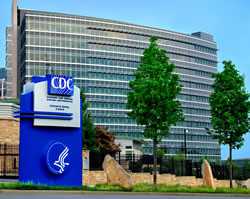Sustainable CDC
By implementing policies, practices, and actions that promote health through environmental stewardship, we protect our workforce and the public we serve.

The CDC Office of Sustainability was created in 2008 to promote health and well-being, quality of worklife, and environmental stewardship throughout the CDC community. In an effort to coordinate sustainable activities around the
Agency, CDC created the Go Green, Get Healthy initiative, comprised of ten sustainability workgroups that serve to organize grassroots volunteers and provide a structure for their input and involvement. These groups work in conjunction to unify our vision and mission.
Vision: A green and healthy CDC
Mission: To promote health and well-being, quality of worklife, and environmental stewardship throughout the CDC community.
Sustainability, at its essence, is the capacity to endure. Our health is inextricably linked to the health of our planet(https://wwwdev.cdc.gov/climatechange). At CDC we focus on the health of the American people, and we need to remember to extend this commitment to our own people and their health and wellness needs.
Healthy people depend on a healthy environment. In order for CDC to maintain its commitment to safer, healthier people, we must minimize or eliminate any negative environmental impact of Agency operations.
Sustainability initiatives at CDC are guided by Executive Orders 13423 and 13514 and the Department of Health and Human Services Strategic Sustainability Performance Plan. CDC’s sustainability goals are to
- Reduce greenhouse gas emissions
- Conserve resources
- Promote health and wellness
- Lead, communicate, and engage the CDC community
To learn more about CDC’s efforts to meet these sustainability goals, you can visit the CDC Sustainability Scorecard page. You can also view CDC’s Annual Sustainability Reports, which include details about CDC’s sustainability awards, benchmarking data and outreach efforts and provides information about green initiatives, collaborations, programs and events within the Agency.
Reduce Greenhouse Gas Emissions
In keeping with CDC’s mission of protecting public health, the Agency is actively working to reduce environmental impacts from operations, including reducing its greenhouse gas emissions. From 2008 to 2009, the CDC reduced its overall greenhouse gas emissions in all three scopes. CDC’s total greenhouse gas emissions (CO2e ) for 2008 were 240,096.72 metric tons, and those for 2009 were 228,977.55 metric tons-a 4.63% reduction.*
CDC has achieved reductions in greenhouse gas emissions through more efficient fleet vehicle utilization, increased employee commuting by methods other than driving alone, and reduced electricity consumption. We are on the right track, but the goals outlined by Executive Orders and the HHS Strategic Sustainability Performance Plan still provide a challenge that requires increased planning and contributions from all levels.
*Data from CDC GHG Emissions-2008/2009 Inventory Final Report (2010) by Working Buildings.
Conserve Resources
CDC made significant strides in 2010 toward reducing, reusing, and recycling the waste generated by its facilities and operations. Effective waste management contributes to the triple bottom line of sustainability, providing simultaneous benefits to public health, environmental health, and cost-effectiveness.
The President signed Executive Order 13514, establishing a 50% diversion goal for nonhazardous solid waste as well as construction and demolition waste by 2015. HHS, in its Strategic Sustainability Performance Plan, established an identical goal, and CDC has embraced the same. In 2010 CDC enhanced existing efforts to reduce the overall amount of waste generated.
Promote Health and Wellness
Earlier this year, Dr. Frieden released a statement that reiterated this key point: “Sustainability is an integral part of our mission because healthier, safer people depend on a healthy environment.” Protection of the public’s health is the priority of CDC, and ensuring that our own workforce remains healthy helps us to achieve this larger goal.
Wellness programs, like those offered by CDC, provide tools and motivation for employees to maintain healthy lifestyles. CDC continues to strive to demonstrate the importance of such programs and their critical link to the Agency’s mission. A number of 2010 initiatives encouraged managers and their employees to make time to lead by example and consider bicycling, carpooling, or vanpooling to work, personally visiting the CDC’s Garden Market, taking a few minutes to eat lunch with colleagues away from their desk, attending a Lifestyle seminar, working out at the gym, using the stairs, or walking to meetings instead of calling in.
Lead, Communicate, and Engage the CDC Community
In order to meet CDC’s sustainability goals, the Agency must engage the entire CDC community in the effort. This community includes CDC employees, contractors, grantees, and partners, who each make decisions that contribute to CDC’s impact on the environment. Go Green, Get Healthy communicates its sustainability messages to these audiences through face to face communication, emails, displays, signage, Intranet pages, and through our Twitter handle @CDCGreenHealthy.
The Agency also bears a responsibility to communicate the link between health and sustainability to the general public. Through use of social media outlets, maintenance of our Internet pages and the release of an Annual CDC Sustainability Report, we aim to spark sustainable conversations and cultivate the knowledge of the population who has the power to green our world.
CDC Recognized WITH HHS Green Champion Awards
In 2010, CDC was recognized for outstanding sustainability efforts for Laboratory Recycling and Electronics Stewardship and received an honorable mention for the Styrocycler project.
CDC received the 2010 Federal Electronics Challenge Silver Award
The Federal Electronics Challenge is a partnership program managed by the U.S. Environmental Protection Agency and the Office of the Federal Environmental Executive that encourages federal facilities and agencies to purchase, use, and reuse electronics in an environmentally safe way.
CDC RECEIVES 2009 PACE Award
The Clean Air Campaign awarded CDC the 2009 PACE Award for commitment and leadership in promoting commute alternatives in the public sector (government employer of any size). Read more
- Page last reviewed: November 12, 2014
- Page last updated: November 12, 2014
- Content source:


 ShareCompartir
ShareCompartir